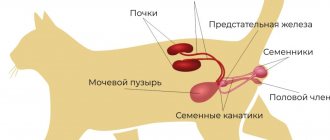Many owners who decide to castrate their pet are often tormented by doubts for a long time. The fact is that over the entire period of its use, a lot of rumors and outright misconceptions have arisen around the sterilization procedure, which does not add confidence to breeders who fear for the health of their pets. Thus, it is believed that a cat’s behavior can change dramatically after castration. Some cat lovers even believe that the cat will immediately lie down on the sofa and quickly begin to get fat... But is this really so? Let's find out!
What is it and how is it done?
Before considering how cats tolerate castration and other nuances of the intervention, we should dwell on the definition and types of manipulation.
During the procedure, the male’s testes are not simply removed, as is commonly thought, but the animal’s sexual function is also stopped, so different methods are used:
- Surgical method - performed through surgery. During it, the doctor opens the animal’s scrotum, removes the testes and ligates the canals.
- Medical sterilization. An implant is sewn under the animal’s skin, releasing drugs that suppress sexual instincts. The procedure is expensive, but is considered the safest.
- Chemical castration. In this case, substances are introduced into the testes that kill glandular tissue, which is subsequently replaced by connective tissue.
- Radiation sterility. In this case, the testes are placed under a source of gamma radiation. The method is quite simple, but the appropriate equipment is rarely found in clinics.
So, not every case requires a scalpel. The available choice of methods allows you to sterilize even old pets without risking their health and life. The veterinarian decides which castration is best for a cat, taking into account the age, health status of the animal and the capabilities available at the clinic.
In our country, they most often resort to the classical method of surgery. The reasons for this are the simplicity and cost-effectiveness of the technique. Let's dwell on it in more detail.
Early Intervention
Proponents of early sterilization recommend it be carried out at the age of two months. At this time, the genitals are not yet formed, and the regenerative capabilities of tissues are maximum. How do cats recover after castration performed at 2 months of age? After surgery, the pet recovers quickly, and the risk of developing postoperative complications is low.
However, there are also disadvantages. In case of early castration, the growth of the animal can be significantly slowed down, and the cat will remain miniature, which in adulthood will lead to problems in the skeletal, muscular and cardiac systems.
In what cases is it necessary to contact a veterinarian?
The recovery process after surgery is usually easy and lasts about a week. Slight changes in behavior, redness, and swelling in the genital area are considered normal. The “patient” needs to be monitored; if the condition worsens, consult a doctor.
Abnormal postoperative manifestations:
- continuous bleeding;
- the pet is in severe pain and meows loudly;
- severe swelling and redness in the operated area;
- complete refusal of food, even your favorite canned food;
- high temperature, accompanied by trembling and thirst.
It is strictly forbidden to carry out independent therapeutic measures. This threatens to worsen your health.
Surgery in adulthood
If late castration is performed - after the age of 2-3 years, in this case the behavior and habits of the animal are entrenched, coping with them can be difficult, and sometimes impossible. In addition, after late intervention, the risk of developing obesity and the appearance of urolithiasis in the animal is extremely high.
Thus, veterinarians believe that both early and late neutering are not very desirable. The ideal period for the operation is considered to be from 6 months to one year. At this time, sex hormones have not yet greatly influenced the development of the male, and the condition of the organs is ideal for intervention.
Veterinarians advise British cats to be neutered at the age of at least eight months. Persian - upon reaching one year. This is due to the later sexual development of these breeds. If they undergo surgery at an earlier age, the likelihood of negative consequences increases.
The nuances of castration of older cats
If the owner decides to undergo surgery on a pet that is more than three years old, a number of points should be taken into account:
- Castration is performed only under general anesthesia. Local anesthesia at this age is not effective and can cause painful shock.
- Adult cats recover from anesthesia quite difficult, and therefore the owner should be attentive to the condition of the pet.
- Preparation for the operation is required, which includes blood and urine testing. This allows you to determine whether the animal has chronic diseases.
- It is also worth conducting an allergy test to identify a reaction to anesthesia.
What to expect in the first hours after castration?
In general, nothing significant, especially in cases where castration was carried out under general anesthesia. The fact is that your pet will sleep for at least three to four hours after the operation. Making loud noise and, especially, trying to wake him up at this time is not the best idea. Moreover, it is recommended to place the animal in a separate darkened room so that the process of recovery from anesthesia is more gentle and natural.
Evidence of a cat’s normal condition is:
- Calm and measured breathing. By the time awakening begins, it becomes more superficial and frequent.
- Normal body temperature. The animal should be neither too cold nor too hot.
- Visible mucous membranes should have a normal pinkish tint.
As a rule, by the time the veterinarian allows you to take the cat home, the animal begins to recover from the effects of general anesthesia, and therefore basic reflexes should appear. In particular, when the cat's skin is pinched or tingled, twitching and muscle contractions should be noted.
By the time the animal begins to wake up, the intensity of the reflexes will increase.
In cases where the pet does not respond to anything after about five hours after the operation, its breathing gradually slows down, and the mucous membranes turn pale, it is necessary to urgently call a veterinary specialist.
Possible complications
A classic cat castration operation lasts no more than 20 minutes. The recovery period is usually short; the pet recovers from anesthesia in an average day. Veterinarians recommend monitoring the animal for two days after surgery, monitoring how the cat behaves after castration, and not leaving it alone. This is due to the use of anesthesia, the side effects of which may appear during this time.
Some negative consequences of the operation are possible within 2-3 weeks after the intervention.
In what cases is it important to take your cat to the veterinarian:
- Bleeding. Occurs when the seams come apart. The blood flows in a thin stream and stains the fur. Treatment is surgical, so it is important to contact a veterinary clinic as soon as possible.
- Purulent inflammation. Possibly if the wound has become infected. Pus appears green, yellow, white, thick, with an unpleasant odor. Such a consequence is treated with antibiotics.
- Edema. It can develop if dirt or infection is brought into the wound. The scrotum swells, and the animal often experiences pain.
- Hernia. This is tissue loss that can occur, especially if the cat is older. The hernia is removed surgically; it is strictly forbidden to repair it yourself.
- Sepsis. Appears after a secondary complication after inflammation, hernia and other pathologies. At the same time, bacteria enter the blood and the temperature rises. Antibiotics are used for treatment.
- Pulmonary edema. The phenomenon is rare, but extremely dangerous. Due to heart failure, pressure in the pulmonary circulation increases, plasma enters the lungs, and oxygen supply decreases. The animal wheezes, coughs, and turns blue. If you don't get veterinary help quickly, the cat will suffocate.
The likelihood of consequences occurring during surgery at home and in the clinic
Complications after castration in cats occur only if errors were made during the operation. When implementing the intervention at home, the risk of negative consequences is reduced, because the animal feels better in a familiar environment. At the same time, the cat does not have an extra reason for stress, which contributes to the rapid recovery of the body. At home, the animal recovers from anesthesia more easily.
Castration of a cat in a clinic may be accompanied by risks. In most cases, there are other animals in the room, which can cause concomitant diseases.
Possible negative consequences and complications occur both at home and in the clinic if the pet suffers from chronic pathologies.
Reaction to anesthesia
How do cats cope with castration and anesthesia during it? If the animal is diagnosed with heart failure, this may negatively affect the condition after administration of the drug. Also at risk are certain breeds of cats - British, Scottish fold and others.
Signs of complications include severe shortness of breath and heart failure. To prevent this condition, the animal’s heart should be examined before surgery using ultrasound and ECG. If the risk of complications is high, it makes sense to refuse the operation or perform it under local anesthesia.
What is the care after surgery? What are the owner's actions?
Owners often ask the veterinarian how to care for a cat after castration? If local anesthesia was used, this process is greatly simplified. The main thing in this case is to eliminate the stressful state. To do this, the cat is given more attention and affection, and postoperative care consists of treating the wound. It is cleaned daily with a damp cotton swab, treated with an antiseptic and a bandage is applied.
To prevent the cat from tearing the seams, an Elizabethan collar and blanket are put on it for 4-6 days. If any of the negative consequences described earlier occur, you should go to the veterinarian.
Bleeding
This may occur due to several factors:
- insufficient ligation of the spermatic cord stump;
- when the bandaging is too strong, when additional damage occurs;
- poor quality ligature;
- flabbiness of blood vessels, which causes them to rupture;
- low blood clotting;
- varicose veins of the spermatic vein.
Bleeding from the skin of the scrotum is not a complication . This is a normal reaction of damaged tissue. Such hemorrhage is not profuse, the blood flows drop by drop, quickly coagulates, so that it goes away half an hour after castration.
Important! A complication is bleeding from the vessels of the spermatic cord, vas deferens or scrotum.
In this case, the blood flows in a trickle, often small, but sometimes extremely powerful, it all depends on which artery or vein was damaged.
Symptoms. Bleeding can be detected by characteristic traces of blood. In severe cases, anemia, weakness, tachycardia, and the development of shock are added to the symptoms. Sometimes the bleeding becomes internal, so it is detected by pale skin, weakness, and accumulation of blood in the abdominal cavity.
Treatment is only surgical. A repeated resection is performed, the damaged vessel is found, a ligature is applied or it is sutured. To eliminate the symptoms of anemia, you can administer calcium chloride and prescribe iron-containing medications. In severe cases, a blood transfusion is required.
After general anesthesia
How to care for a cat after castration in this case? In the first hours after the intervention, the pet experiences severe weakness, nausea, and dizziness. This is how the animal recovers from anesthesia. What should the owner do after castrating a cat? Sometimes he is offered to leave the animal in the clinic for a day after the operation. However, an animal can only calm down and feel the care of its owner at home.
After general anesthesia, the cat has:
- Dry eyes. During the operation, the cats' eyes do not close; the veterinarian does this manually so that the conjunctiva is moistened with tears. After the procedure, if the pet has not yet recovered from anesthesia, the owner will need to do this. How long does it take for a cat to recover from castration? This may take several hours. If the animal lies with its eyes open for a long time, you can drip saline solution.
- Reduced body temperature. If cats normally have a temperature of 37.5-39.0 degrees, then after surgery it can be 36.5-37.0. To prevent the animal from freezing, it is worth covering it with a warm blanket. To normalize blood circulation, the cat's paws and ears are rubbed.
- Unsteady gait. This is due to the fact that the muscles relaxed during the application of anesthesia. So the pet can walk on the first day after the procedure. It is worth monitoring how the cat behaves after castration, so that the animal does not climb somewhere where it cannot get out.
- Painful sensations. Even though the animal is silent, this does not mean that it is not in pain. After the operation, the cat is in a depressed state and needs painkillers.
After surgery, you need to check the animal's groin area daily and check for bleeding.
To make the stitches heal faster, the wound is treated with hydrogen peroxide and brilliant green. You can also lubricate with Levomekol.
The doctor may prescribe a 5-day course of antibiotics to avoid possible complications.
Wound care
During the recovery period, the owner should inspect the stitches 1-2 times a day and ensure that there is no bleeding. To speed up the healing of the wound, it is lubricated with hydrogen peroxide, brilliant green or Levomekol ointment. If the cat shows increased attention to the wound and constantly licks it, a special collar should be put on the animal. It will protect the seam from coming apart under the influence of your pet’s rough tongue.
To avoid wound infection, after each visit to the toilet, the tray should be thoroughly washed and treated with an antiseptic. Antibiotics can also be used to prevent infections, but be sure to consult a veterinarian before use.
The cat's toilet after the procedure
During the postoperative period, light-colored litter should be poured into the cat's litter box in order to notice possible bleeding in time. It is better to purchase a soft adsorbent to avoid irritation.
After castration, some owners put a small diaper on their pet, in which they have previously made a hole for the tail.
It may be that the cat does not have a toilet for a long time - neither big nor small, or the urine comes out little by little. This is quite normal.
Vaseline oil will help cope with constipation. It is poured into the animal’s mouth in a small amount; if after 20 minutes no negative reaction is observed, another 15-20 grams are given. After 3 hours, the animal's intestines should gently empty.
How and what to feed?
In the first hours after castration, the cat does not eat anything because his appetite is reduced. You should not force feed an animal. However, water must be available to him in sufficient quantities.
Castrated males have an increased risk of developing urolithiasis, so veterinarians do not recommend feeding such animals fish. It contains increased levels of phosphorus, calcium and magnesium, which can lead to the formation of stones in the urinary system.
Experts advise purchasing special dry food for castrated and sterilized cats and feeding the animal with it. The composition of this diet acidifies the urine, which prevents the occurrence of urolithiasis. But at the same time, the cat must drink more liquid in order to go to the toilet normally. The feed to water ratio should be 1:3. If your pet rarely goes to the toilet, you should contact your veterinarian for a diuretic prescription.
In general, a neutered cat asks for food more often. This does not mean that he is hungry. It’s just that his interests are shifting away from cats, and the resulting void needs to be filled with something. The owner should not follow the lead of the animal, otherwise obesity is very close.
If the cat is not castrated: consequences
Opponents of sterilization claim that there are countless uncastrated cats in the world who feel excellent and live quite a long time. Nobody takes care of stray animals; their numbers are huge.
But if they had undergone surgery to remove the gonads, they would have been able to avoid unnecessary consequences:
- Serious injuries, bites. Males during a female's heat period fight among themselves for the right to have territory and companions. They inflict severe injuries: they bite deeply, tearing the skin.
- Infectious diseases. A sexually mature animal copulates instinctively. The pet seeks to escape from the apartment in search of mating. As a result of contact with a stray “lady,” the “gentleman” becomes infected with an infectious disease.
- A predator that leaves home in search of a female is poorly adapted to street life and can get hit by a car.
- A domestic animal on the street is defenseless; it can be caught by flayers for abuse.
Be sure to read:
After sterilization, the cat does not eat or drink for several days: what to do, what to feed
Having run away from the owner, the pet will not be able to return. He does not know how to get food and will die of hunger.











